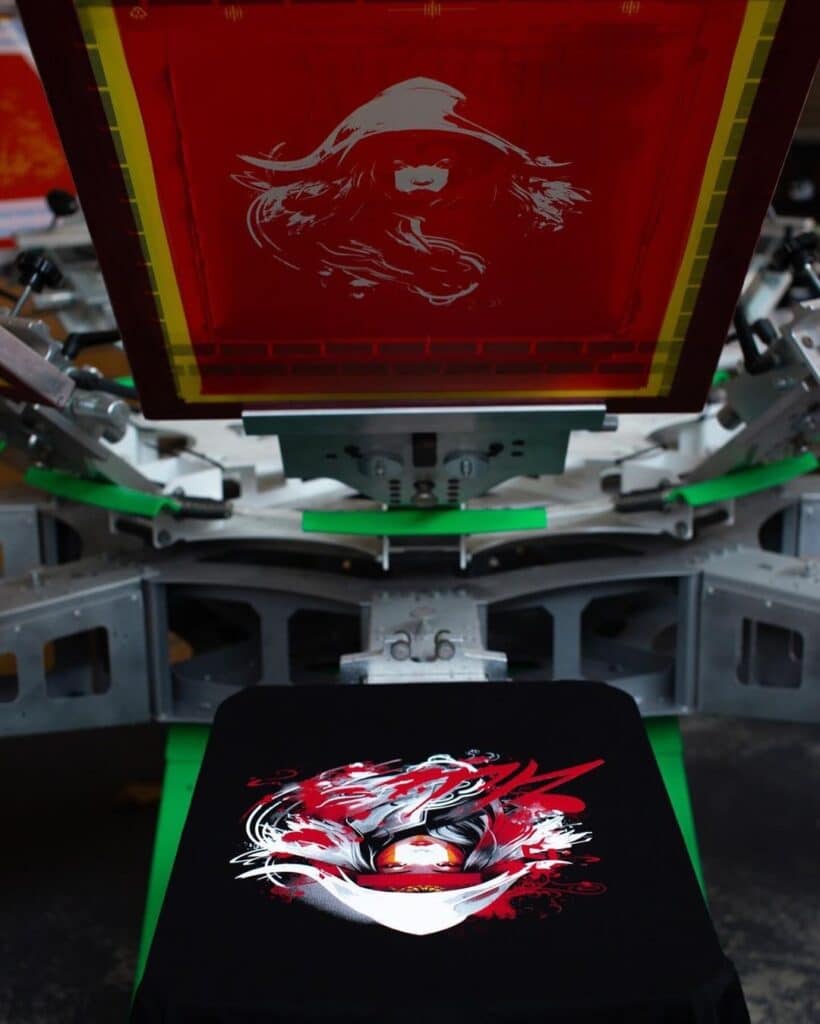Water-Based vs Plastisol Inks for Screen Printing: What’s the Difference?
When it comes to screen printing inks, the choice between water-based and plastisol inks can significantly impact your results, process and environmental footprint. Understanding the characteristics of each ink type is crucial in making an informed decision for your printing projects.
What are Plastisol Inks?
Plastisol inks are formulated using pigment and (usually PVC) resin particles suspended in a plasticiser medium, which generally lacks volatile components. The ink must be heated to cure, resulting in a solid film adhering to the fabric. Typically, curing a plastisol print occurs relatively quickly (20-60 seconds) at temperatures over 160 °C (320 °F), resulting in the formation of a continuous film that sits on the fabric. Plastisol inks are prized for their adaptability and longevity, making them a favoured choice for a wide range of applications.
What are Water-Based Inks?
Water-based inks are formulated by dispersing pigment in a water-based medium, usually with acrylic polymers as the resin. Curing is achieved through a combination of water evaporation and a cross-linking process triggered by heat. These inks are acclaimed for their soft texture, ecological friendliness and the comfort they offer when applied to wearable textiles. Water-based colour mixing systems allow you to achieve a wide spectrum of vibrant hues for your screen printing projects.
Opaque water-based inks, often referred to as High Solids Acrylics (HSAs), provide excellent coverage on dark fabrics, making them a preferred choice for designs that demand bold and vivid colours even on challenging backgrounds.
What’s the Difference between Water-Based and Plastisol Inks?
When it comes to selecting the best screen printing ink for fabric or any type of design, understanding the differences between water-based and plastisol inks is crucial. We’ll delve into a comprehensive comparison of the properties, curing processes, tactile sensations and environmental impacts of water-based and plastisol inks. This understanding will help you make an informed choice for your screen printing projects.
Water-based Inks
Water-based inks are dispersions of pigment or dye in a water-based medium with acrylic polymers as a typical resin. They generally cure first through the evaporation of water and/or other volatile components and then with heat to cross link. Water-based inks are recognised in textile printing for their soft hand leading to better wearing experience, environmental benefits and ease of clean up.
Properties
Plastisol inks offer a durable solution for various fabrics and designs. Their ability to cover dark and light fabrics without affecting the colour of the print is touted as an advantage. On the other hand, water-based inks excel in unsurpassed softness, even application and breathability, even accommodating challenging materials like towelling. For dark fabrics, simply switch to an opaque HSA.
Process
Plastisol inks cure exclusively through heating, typically taking between 20 to 60 seconds at temperatures exceeding 160°C (320°F). In contrast, water-based inks require a longer curing process, as they first evaporate water, then cross-link with heat. This extended curing time might require additional floor space for drying tunnels.
Feel and Comfort
By far the most noticeable difference between these inks is the tactile experience they provide. Plastisol prints exhibit a harder hand feel and virtually zero breathability. In contrast, water-based prints are prized for a softer touch and superior breathability, ensuring enhanced comfort when worn against the skin.
Environmental Impact
Considering the environmental impact is essential and here, water-based inks shine even brighter. The cleanup process for water-based inks is eco-friendly, as they can be easily cleaned up with water. In contrast, plastisol inks involve hazardous chemicals; in their manufacturing, use and disposal processes, leaving printers to address concerns about health risks and environmental impact. Water-based inks, without harmful chemicals, contribute to a much more sustainable approach to screen printing and a much healthier workplace.

Which ink should you choose?
When making the decision between water-based and plastisol inks, several factors come into play. In this section, we will analyse considerations such as fabric type, design complexity, budget constraints and environmental factors. This holistic comparison will guide you toward selecting the ink that aligns best with your artistic goals and values.
Type of Fabric
The choice between water-based and plastisol inks can be guided by the type of fabric you’re working with. Water-based inks are an excellent fit for fabrics that require flexibility and breathability, providing a comfortable and pleasant wearing experience. On the other hand, if durability is your primary consideration, plastisol inks might be more suitable, but are prone cracking as the plasticiser leaches out over time.
Type of Design
Design considerations can play a role in this decision. Water-based inks are favoured for intricate designs, as they offer superior coverage and an even application over various fabrics, but plastisol inks can be preferred for more conventional designs.

Budget
Water-based inks may demand a more rigorous screen preparation regime, but they offer long-term benefits. Their more eco-friendly production process and lower potential health risks can be viewed as an investment in both the quality of your prints and the well-being of your staff and/or studio colleagues.
Environmental Friendliness
For environmentally-conscious artists and print shops, the choice becomes clearer. Opting for water-based inks aligns with a more sustainable approach, contributing to reducing the harmful effects of plastisol inks on health and on the planet.
Choose the Right Ink for Your Art
The balance between plastisol and water-based inks depends on the specific needs of your project and your commitment to environmental responsibility. Water-based inks offer a softer feel, better breathability and a reduced environmental footprint, while plastisol inks provide durability.
Ultimately, the choice you make should reflect both your artistic vision and your values.
The choice between water-based and plastisol inks extends beyond surface-level differences. It encompasses factors like fabric type and colour, design intricacy, budget constraints and environmental impact. Water-based inks not only promise a comfortable wearing experience and detailed prints but also contribute to a healthier planet. By embracing these inks, you’re not just enhancing your artistry, but also taking strides towards a more sustainable future for the printing industry.
If you’d like to make the switch to eco-friendly inks, browse our selection of water-based screen printing inks. Embrace vibrant, high-quality colours while reducing your environmental footprint. Get in touch with our team to find out more!
